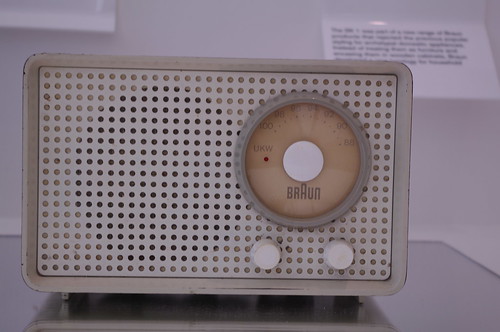This post on digital experiences sprang out of my going through images on Flickr. I was looking at pictures that I had taken of products designed by Dieter Rams like the Vitsœ 606 shelving system and his work at Braun on the service. Rams’ approach to industrial design was part of the functionalism movement where the look of a product is dictated by what the object does. In architecture this was used as an excuse to build rough-looking buildings with little aesthetic appeal. This partly explains by a number of the leading thinkers in modern architecture have taken a ‘user’ hostile approach to their designs, washing their hands of having to think about form in their process at all.
The Braun SK1 radio designed by Dieter Rams
Rams approach to design had quality very much at the centre of it, so his work has as much to do with the ethics and principles of traditional Japanese design as it had with a modern movement. I got into this chain of thought because digital largely fails to mirror the good design that Rams has done in the analogue age. Rams in an interview for the documentary Objectified says that Apple seems to be only modern company that subscribes to his principles of good design, or takes design as seriously as he did.
So why are digital experiences failing to match the best analogue examples of product design? I have some ideas, but I wouldn’t pretend to think that they are definitive answer to the question.
Horizontal industry structure affects design thinking
When geeks wore ties, polyester shirts and pocket protectors technology companies used to make the hardware and the software and digital experiences that went with them. Economies of scale and standardisation brought about a business computing environment based on Microsoft operating systems and Intel X86 processors. The exceptions to this being a small amount of powerful UNIX workstations and Apple’s range of Macintosh computers. In web services it splits up via hosting and APIs at the very least. This tends to be very different to many manufacturing processes and leaves designers with a sense that they have comparatively little control over their devices. It also means that the point of interface between designs: like how to interact with the software is dictated by the software partner, not the device manufacturer. In digital services, the terms of service of the API limit the power and design choices made.
Design isn’t taken seriously
In hardware manufacturing businesses work with manufacturers like Foxconn Technology Group. These manufacturers have moved up the value chain doing more and more of the work around the product including design now. There are few manufacturers that keep much of that work in-house. Reference designs make tooling easier, give component manufacturers more power and allow the client get to market faster. But they are going to market with a commoditised offering. This isn’t a new phenomena: JVC used to make VHS video recorders for Ferguson under the Videostar name with only the branding changing some 3o years ago.
Outsourcing design implies that the process isn’t core to the value proposition of the business, and that’s a shame.
Focus on the ingredients rather than the cake
If you look at the marketing of mobile and computing devices the adverts often read like a parts list rather than a marketing brochure. How many car magazines publish articles showing the components that make up the engine, who they are manufactured by and how much the car would have cost? How would really care about which brand of air filter the engine used? Yet tear-downs are an important part of consumer electronics coverage now. The focus on the ingredients probably started as a way for manufacturers to take some control of their own product as part of the horizontal industry eco-system; but now it has become a fetish. A great micro-processor is often not enough to make a phone great when consumers choose on all-up experience.
It isn’t only hardware manufacturers who do this. When I worked in-house for Yahoo!; the company launched lots of different search products to try and get feature parity with Google’s offerings. They were good products but the consumers still stayed away in droves; mainly because it wasn’t enough to be just like Google. If the company had carved its own path the future may have been very different.
Quality is relative
If you think about buying a new car or a fridge-freezer being told that you could use it, but it wasn’t fully finished and would be subject to considerable change – you would be very worried and I wouldn’t blame you. However software and services change, sometimes quite dramatically. It means that quality means something very different in the digital world, compared to the world that you and I live in. There is no ‘getting things right first time’ and there is a mentality of impermanence, the idea that anything can be fixed.
The user case is malleable
The malleable nature of digital services and applications mean that the user case may not have even been dreamt up at the design stage. Thinking for a moment about Twitter, it has morphed into an extremely dynamic system of interactions:
- The hashtag accompanies events acting as a public ‘back channel’ where previously the technologically savvy would have used IRC (internet relay chat) and the rest of us probably were oblivious to it all
- It has raised money for charities, and has been directly responsible for helping Dell to sell refurbished computers
- It has been the rallying point for political action
- It is history in the making as the Library of Congress has been archiving tweets
Given those vast differences it is understandable why it’s hard to design for use cases and hard to get great digital experiences.


